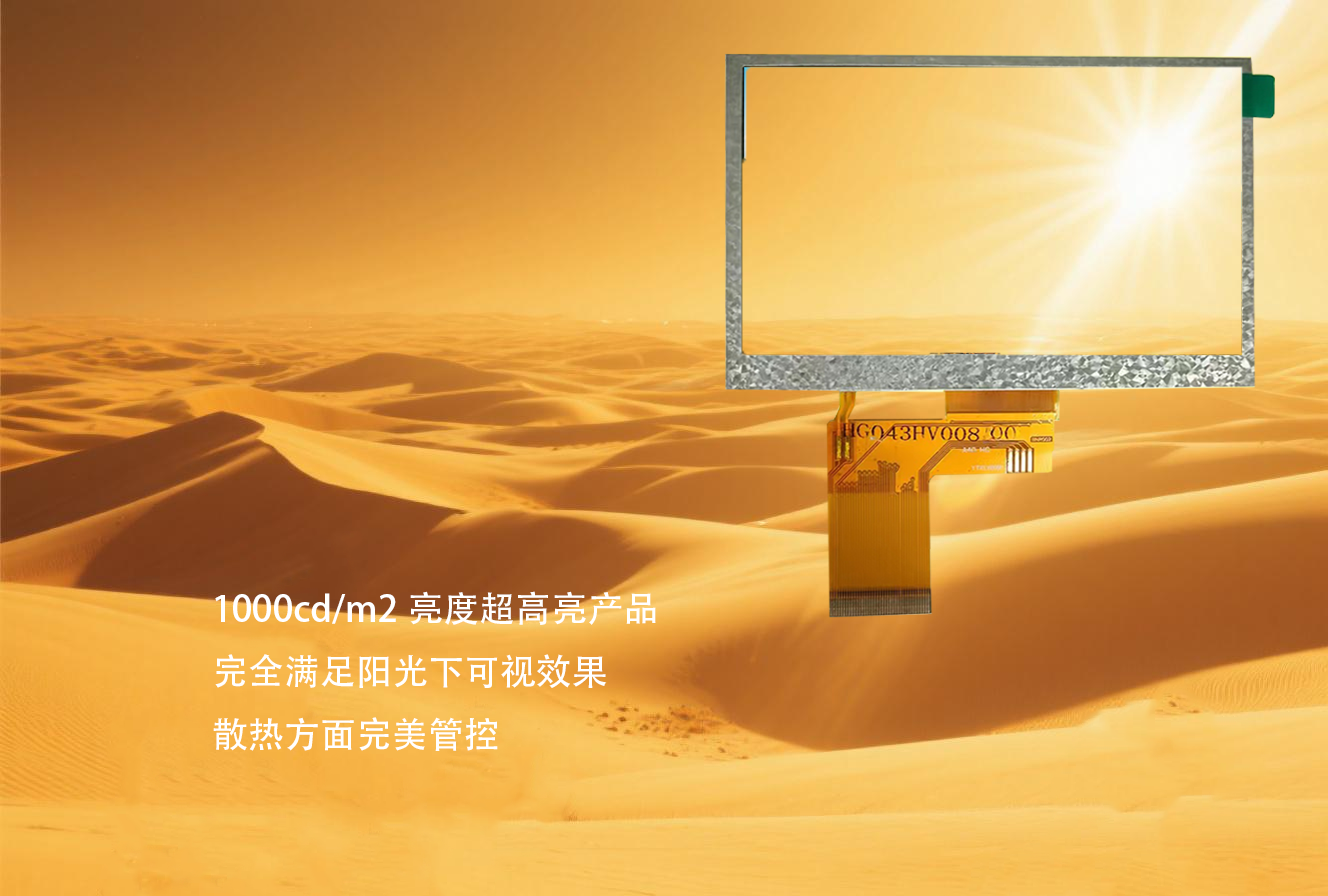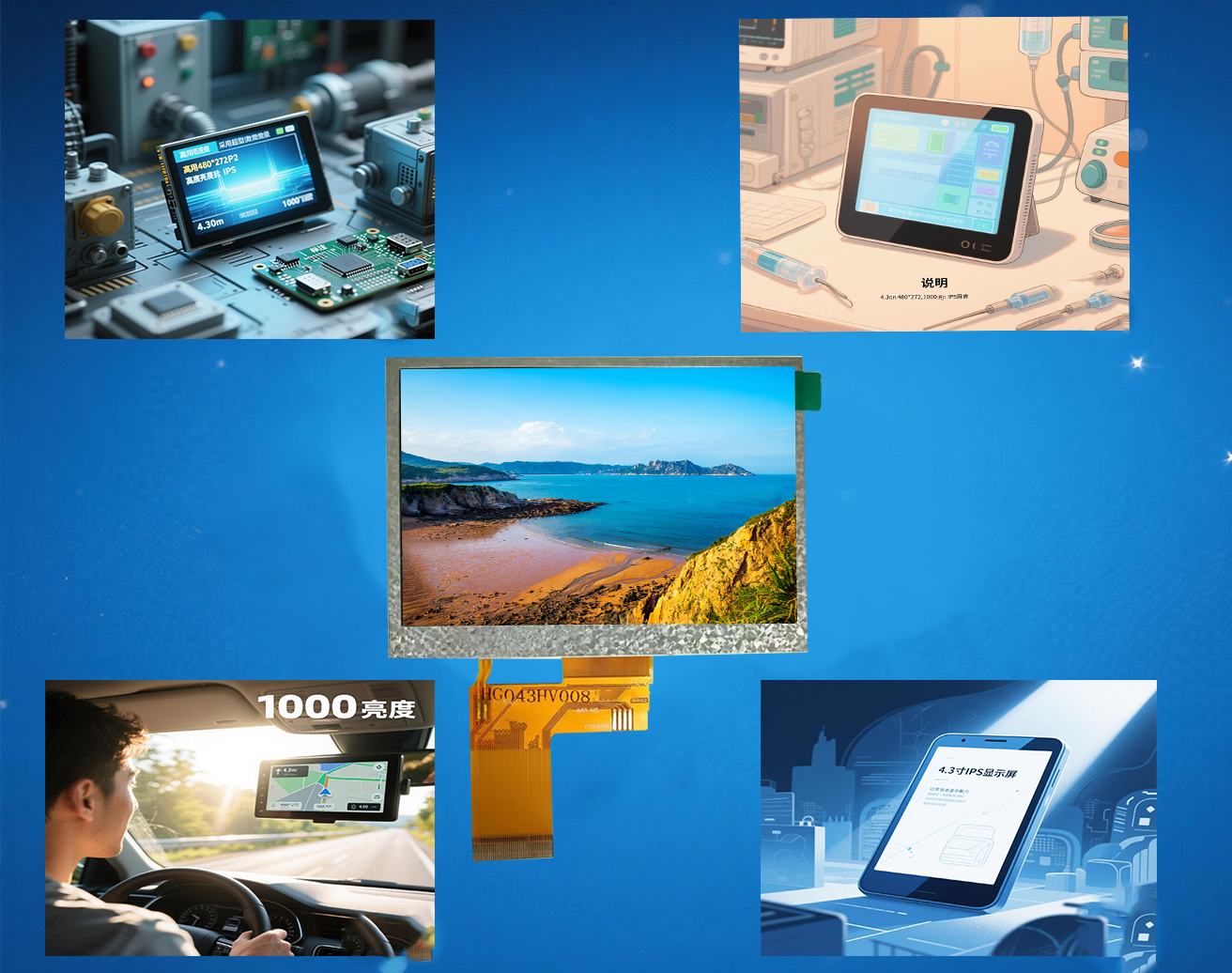
Explore the outstanding performance of the 4.3-inch 480×272 resolution, 1000-nit brightness IPS display.
Introduction
In demanding environments such as industrial control, automotive displays, and outdoor equipment, display visibility, durability, and color accuracy are critical. The 4.3-inch 480×272 resolution IPS display with 1000-nit brightness stands out as an ideal choice for professional applications due to its high brightness, wide viewing angles, and robust performance. This article delves into the display’s core advantages, technical features, and typical use cases to help users understand its superior capabilities.
I.Core Performance Analysis
- Ultra-High Brightness (1000 nits) for Harsh Lighting Conditions
While standard consumer displays typically offer 200-300 nits of brightness, this IPS display reaches an impressive 1000 nits, ensuring clear visibility even under direct sunlight.
deal Applications: Automotive dashboards, outdoor digital signage, construction machinery control panels.
Advantage Comparison:
Standard Display (300 nits): Requires shading in sunlight, poor visibility.
1000-nit Display: Remains clearly readable in bright outdoor conditions, minimizing glare.
- IPS Technology for Wide Viewing Angles & Accurate Colors
Featuring In-Plane Switching (IPS) panel technology, the display provides a 178° ultra-wide viewing angle, eliminating color shifts or brightness loss from any angle.
Color Gamut: Covers ~72% NTSC for true-to-life color reproduction.
Best for: Medical devices, industrial control panels, and other scenarios requiring multi-angle viewing.
- 480×272 (WVGA) Resolution – Balancing Clarity & Power Efficiency
On a 4.3-inch screen, the 480×272 resolution (~137 PPI) delivers sufficient sharpness while maintaining low power consumption, making it ideal for embedded systems and battery-powered devices.
Key Benefits:
Lower GPU load compared to high-resolution screens (e.g., 720p), improving energy efficiency.
Native compatibility with legacy industrial systems, eliminating additional driver optimization.
- Rugged Design for Extreme Environments
Wide Operating Temperature: -30°C to 80°C, suitable for freezing or high-heat conditions (e.g., cold chain logistics, desert equipment).
Enhanced Durability: Optional anti-glare coating, tempered glass (G+G structure), and shock-resistant design.
II.Key Application Scenarios
- Industrial Automation (HMI Interfaces)
Used in PLC control panels and automated production line monitoring, where high brightness ensures readability in bright factory environments.
Wide viewing angles facilitate multi-user operation, improving workflow efficiency.
- Automotive & Transportation Systems
Dashboards for heavy-duty trucks and construction vehicles, resisting sunlight and vibrations.
Public transit information displays (e.g., buses, subways), maintaining visibility outdoors.
- Outdoor Terminal Equipment
EV charging station interfaces, vending machines—high brightness enhances user experience.
Portable inspection devices (e.g., power grid maintenance tools), adaptable to varying lighting conditions.
- Medical & Military Devices
Handheld diagnostic equipment (e.g., ultrasound scanners), where wide angles aid medical
professionals.
Military communication terminals, with wide-temperature operation ensuring reliability in extreme climates.

4.3-inch 480×272 resolution, 1000 brightness IPS display screen is applied in industrial, medical, automotive, handheld and other fields.
III.Selection & Optimization Tips
- Interface Compatibility
Prioritize industrial-standard interfaces (e.g., RGB, LVDS) over consumer-grade MIPI to avoid compatibility issues.
Some models support touch functionality (capacitive/resistive)—choose based on application needs.
2.Power Efficiency
High brightness (1000 nits) increases power consumption (~3.5W vs. 2W for standard displays)—ensure power supply compatibility.
Consider dynamic brightness adjustment to save energy in indoor settings.
3.Customization Options
Anti-reflective coatings, wide-voltage input (12V/24V), and custom shapes (circular/irregular) are available.
IIII.Competitor Comparison
Feature | Standard IPS (300 nits | 1000-nit IPS Display |
Outdoor Readability | Requires shading, prone to glare | Clear under sunlight |
Viewing Angle | 178° IPS | 178° IPS |
Operating Temp | 20°C to 70°C | 30°C to 80°C |
Typical Powe | 2W | 3.5W |
Conclusion
The 4.3-inch 480×272 IPS display with 1000-nit brightness excels in high visibility, wide viewing angles, and ruggedness, making it a top choice for industrial, automotive, outdoor, and medical applications. While slightly more expensive than standard displays, its reliability in extreme conditions justifies the investment.

